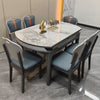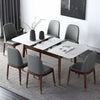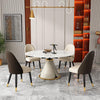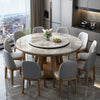Choosing the Perfect Dining Table
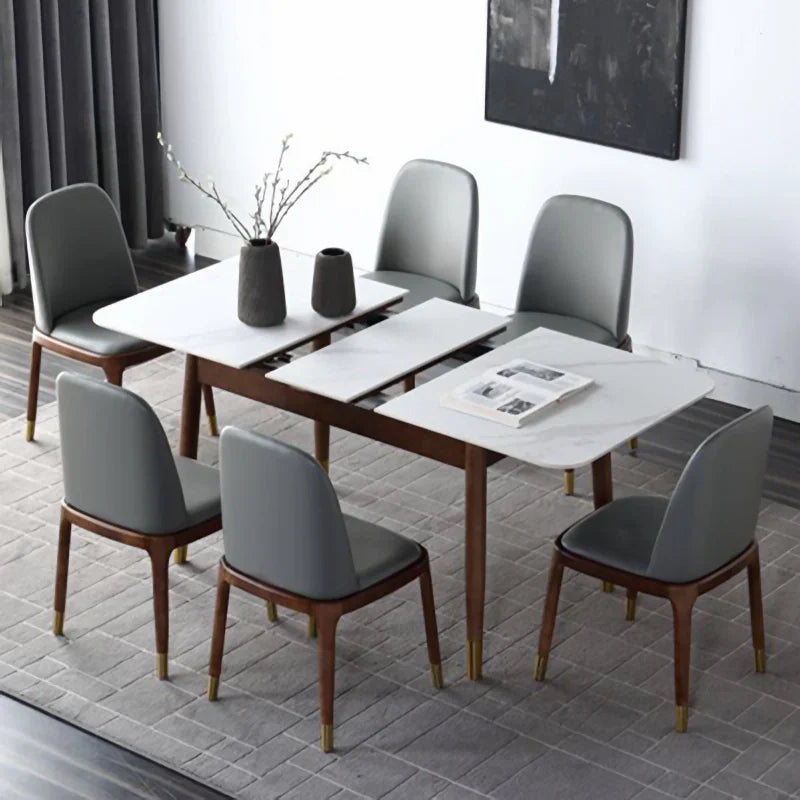
Introduction
The dining table fosters connection, style, and functionality in a home. It is more than just a piece of furniture. Choosing a dining table involves considering several factors. These factors include size, seating capacity, budget, style, and decor.

Types of Dining Tables
Wood
Characteristics: Wood offers warmth and natural beauty, seamlessly fitting into various home styles. Hardwoods like oak, walnut, and teak are durable and feature rich tones, while softwoods such as pine and spruce offer a more rustic charm with lighter colors.
Suitable for: Wood tables work well in traditional, rustic, or farmhouse-style dining rooms. Rubberwood is durable, wear-resistant. Solid wood veneer tables are more durable than pure solid wood tables and are more adaptable to environmental conditions, with better resistance to wear, humidity and stains.

Glass
Characteristics: Glass tabletops are easy to clean and maintain, lending a contemporary look to dining spaces. However, they can be fragile and prone to scratches.
Suitable for: Glass tables fit well in modern or minimalist dining rooms, creating an open and airy feel.
Metal
Characteristics: Metal tables are known for their robustness and low maintenance. They can, however, feel cold and may be prone to scratches over time.
Suitable for: Metal tables are suitable for industrial or contemporary dining spaces.

Stone
Characteristics: Marble provides a luxurious and heat-resistant surface but is heavy, expensive, and requires high maintenance. Granite is extremely durable and heat-resistant but needs sealing and is also heavy. Quartz is highly durable, scratch and stain-resistant, and requires low maintenance, making it ideal for modern dining. Ceramic is versatile, heat-resistant, scratch-resistant, easy to clean, and comes in various styles.
Suitable for: Marble tables are best for upscale, traditional settings. Quartz and ceramic tables fit well in contemporary spaces.

Rectangular: Rectangular tables are a common choice. They suit larger dining rooms and accommodate more people.
Round: Round tables encourage conversation. They work well in smaller spaces, promoting intimacy and easier interaction among diners.
Square: Square tables are suitable for small spaces.
Oval: Oval tables combine the benefits of rectangular and round shapes.
Modern: Modern tables are minimalist. They feature clean lines, simple designs, and often incorporate materials like glass and metal.

Traditional: Traditional tables have classic designs. They often showcase ornate details, rich wood finishes, and formal elegance.
Rustic: Rustic tables feature natural elements. They emphasize raw materials, rugged textures, and a cozy, inviting atmosphere.
Farmhouse: Farmhouse tables are cozy and inviting. They typically feature a simple, sturdy design, often made of wood, creating a warm and welcoming dining environment.

Factors to Consider
Measure the dimensions of your dining area. This ensures the table fits without overcrowding the room. Leave enough space around the table for comfortable movement. Aim for at least 36 inches between the table and walls or other furniture. This prevents a cramped dining space. Select a table size appropriate for your measured space. A too-large table can make the room feel small. A too-small table might not meet your seating needs.
Seating Capacity: Determine your regular seating needs. Consider how many people you need to seat daily. Also, think about how many you might need to accommodate for special occasions. Choose a table that comfortably seats your typical number of diners. For larger gatherings, consider expandable tables. These tables offer flexibility when needed.
Budget: Set a realistic budget. Determine how much you're willing to spend on a dining table. This helps narrow your options. Look for tables that fit your budget. Compare prices and materials. Also, consider sales and discounts.
Style and Decor: Choose a table that complements your home. Assess your current home decor. Consider the style, colors, and materials already present. Select a dining table that enhances your home's aesthetic. Whether modern, traditional, rustic, or farmhouse, ensure the table aligns with your overall design.
Popular Dining Tables in Recent Years
Round Dining Tables: Round dining tables are making a comeback, fostering intimacy and conversation, particularly in smaller spaces.

Statement Making Dining Tables: Instead of excess decor, people are prioritizing bold visual statements through staple furniture pieces. Expect statement-making dining tables with striking bases to be in high demand.
Natural Wood Finishes: Natural wood is making a significant comeback, adding warmth and texture to dining spaces. It works well with modern and rustic styles.
Expandable and Modular Tables: Flexibility is key, with expandable or modular tables that can adapt to different numbers of guests. These tables are practical and stylish choices for every home.

Mixing Modern and Vintage Styles: Dining rooms are embracing the beauty of contrast, mixing sleek, modern furniture with vintage pieces. A glass dining table paired with vintage wooden chairs exemplifies this trend.
Oversized Seating: Large, cozy seating is becoming more popular, inviting people to unwind and stay awhile. Oversized armchairs and deep, lounge-worthy seating create inviting spaces perfect for gathering, making comfort the new standard in stylish living.
FAQs:
1. How do I determine the right size dining table for my space?
Measure your dining area carefully, leaving at least 36 inches between the table and any walls or furniture. Consider the table's dimensions when fully extended if it's an expandable model. This ensures comfortable movement and prevents a cramped feeling.
2. What shape of dining table is best for encouraging conversation?
Round dining tables are excellent for fostering conversation as they allow everyone to see and interact with each other easily. Oval tables offer similar benefits while providing more surface area.
3. How do I choose a dining table material that suits my lifestyle?
Consider your lifestyle and maintenance preferences. Wood offers warmth but may require more upkeep, while glass is easy to clean but can show fingerprints. Metal and stone are durable but might not fit every decor.
4. What is the best way to determine how many people my dining table should seat?
Think about your everyday needs and how often you host gatherings. Choose a table that comfortably seats your family regularly, and consider expandable options for accommodating guests during special occasions.
5. How can I ensure my new dining table complements my existing home decor without breaking the bank?
First, set a budget. Next, assess your home's current style and choose a table that aligns with it. Consider the color, material, and overall design. Look for affordable options that still capture the desired aesthetic. Mixing modern with vintage pieces can also be a great way to create a unique and budget-friendly look.

